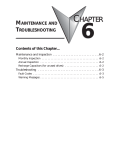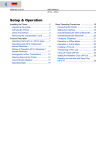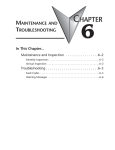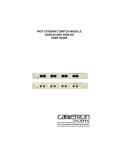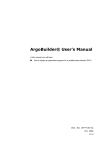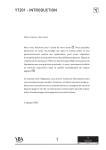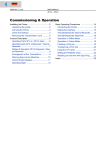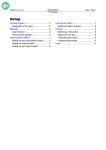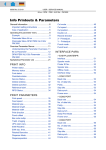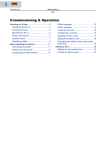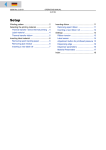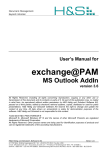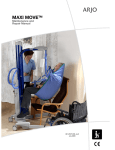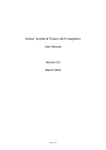Download Application - Avery Dennison
Transcript
05/10 Rev. 5.04-01
USER MANUAL
Plugin Cards
Application
Using the cards .............................................. 2
Logo card ....................................................... 2
Application.................................................. 2
Formatting .................................................. 2
Loading data .............................................. 2
Font card........................................................ 3
Application.................................................. 3
Loading data .............................................. 3
Selecting fonts............................................ 4
Symbol cards ............................................. 4
Symbol card "Textile Care Symbols".......... 4
Symbol card "Electric and VDE symbols" .. 6
Symbol card "Indications of Danger".......... 7
Color card ...................................................... 8
Application.................................................. 8
Formatting .................................................. 8
Programming.............................................. 8
Status reports ............................................. 8
Speedo card................................................... 9
Application.................................................. 9
Data preparation ........................................ 9
Loading data .............................................. 9
Selecting fonts.......................................... 10
Format card / Easy Plug card ...................... 11
Application................................................ 11
Loading data .............................................11
Selecting formats ......................................11
Status reports............................................12
Database card ..............................................13
Application ................................................13
Layout of the database file........................14
Loading data .............................................15
Status reports............................................15
Image card....................................................16
Application ................................................16
Formatting.................................................16
Maximum print length................................16
Bar code card ...............................................17
Application ................................................17
Programming ............................................17
Maximum print length................................17
CF/SD-cards.................................................18
Application ................................................18
Font directory ............................................18
Logos directory .........................................19
Graphics directory.....................................20
Formats directory ......................................20
Logfiles directory.......................................20
Index.............................................................21
2
05/10 Rev. 5.04-01
USER MANUAL
Plugin Cards
Application
Using the cards
Memory cards can be deployed and used in different ways depending on
the printer in question.
The table below gives details of the individual card types, under which
menu item (on the printer) they can be selected, how and where they are
formatted, and how many files can be stored on each card.
The Compact Flash card is a special case. It can be used to store formats
as well as fonts, logos and other data types.
Card type
Menu item
Easy card
Format card
Formatting
Formatting
No. of files
–
DOS
unrestricted
–
DOS
(max. memory)
Logo card
LCLR
internal
Font card
DOWN
internal
DOS
1 (v55_card.bin)
Speedo card
DOWN
internal
DOS
1 (promfile.bin)
DOS
unrestricted
DOS card
–
Data Base card
–
DOWN
internal
1 + index
–
internal
–
Image card
LCLR
internal
–
Color card
CCLR
internal
–
Bar code card
Compact Flash card
–
DOS
unrestricted
Logo card
Application
The logo card is used for saving different images (logos) and to make them
available to the printer when required.
Formatting
The card is prepared for use as a logo card in the printer with the
parameter LCLR.
Menu item
OTHR/LCLR
(see Info Printouts and Parameters)
The memory capacity varies according to the printer and card.
Loading data
Logos are downloaded by sending the #DK command to the printer.
Download
#DK
(see Easy Plug manual)
3
05/10 Rev. 5.04-01
USER MANUAL
Plugin Cards
Application
Font card
Application
Font cards are used to make available additional fonts which are not
included in the standard font generator of the printer, allowing customer or
application-specific fonts to be used conveniently without changing the
EPROM.
Defined fonts
Fonts are saved in a defined size (each character has a fixed size). A
separate font is required for each character size.
P Fonts with variable character sizes: see Speedo card.
Loading data
¯ FLASH RAM cards which are to be used as font cards can only be
programmed ex works.
There are two methods for using SRAM cards as font cards:
– By loading fonts onto DOS-formatted cards on the PC
– By downloading fonts onto the printer
Binary format
However, in both cases the characters must be in *.AFF format
(manufacturer format) and compiled into a binary file using a suitable
programme (manufacturer program).
A component of this binary file is the correct 16 byte header.
File name
¯ If the binary file is copied onto a DOS-formatted card, it must be named
V55_CARD.BIN.
Loading fonts onto the PC or laptop:
1. Format the card under DOS.
2. Copy the binary file V55_CARD.BIN onto the card.
Example: copy V55_CARD.BIN D:
File is copied onto Drive D (PCMCIA slot).
Downloading fonts onto the printer
The card is used without formatting and the binary file is loaded onto the
card using the DOWN function.
Menu item
OTHR/DOWN
(see Info Printouts and Parameters)
Example: copy V55_CARD.BIN lpt1
File is transferred to the printer via the LPT1 interface.
4
05/10 Rev. 5.04-01
USER MANUAL
Plugin Cards
Application
Selecting fonts
The manner in which fonts are selected varies according to the control
software being used.
Easy Plug
When selecting fonts with Easy Plug, the first font on the card is selected
with the number #YT200, and the subsequent fonts with incrementing
numbers (#YT201, #YT202 etc.).
MVT 3
With the software MVT 3 the first font is selected as C1, subsequent fonts
with incrementing numbers (C2, C3 etc.).
Jetmark
When using Jetmark fonts are selected as Card Font 0, Card Font 1 etc..
However, the WYSIWYG view does not function for these fonts as Jetmark
is not informed about the font type.
Symbol cards
Symbol cards are a special type of font cards, containing symbol fonts
instead of character fonts. Those may e.g. be textile care symbols,
indications of danger or electric symbols. Symbols can be used additionally
to the printer fonts.
Symbol card "Textile Care Symbols"
¯ The listed textile care symbols are in this assignment only contained on
plug-in cards with one of the following part numbers:
Part Number
Usable for printers:
93099-50-9
TTX 300 Offlline, TTX 600, TLX 604, TTX 507 (alt),
TTX 807, TTX 7xx
97286-50-9
TTX 300 Online, TTX 507 (neu)
98886
TTX x50, TDI, TTK
Tab. 1
Part-numbers for symbol cards with textile care symbols.
Font no.:
for use with 8 Dot printheads
200 (Easy Plug)
C0 (MVT II, III)
ASCII A – G
dez. 65 – 71
hex. 41 – 47
A B C D E F G
ASCII H – N
dez. 72 – 78
hex. 48 – 4E
H I J K L M N
ASCII O – U
dez. 79 – 85
hex. 4F – 55
O P Q R S T U
ASCII V – Z
dez. 86 – 90
hex. 56 – 5A
V W X Y Z
5
05/10 Rev. 5.04-01
USER MANUAL
Plugin Cards
Application
ASCII a – g
dez. 97 – 103
hex. 61 – 67
a b c
d
ASCII h – n
dez. 104 – 110
hex. 68 – 6E
h i j k l m n
ASCII o – u
dez. 111 – 117
hex. 6F – 75
o p q r s t u
w x y z
ASCII v – z
dez. 118 – 122
hex. 76 – 7A
Font no.:
for use with 12 Dot printheads
202 (Easy Plug)
C2 (MVT II, III)
Symbols identical with font 200 .
Font no.:
for use with 8 Dot printheads
201 (Easy Plug)
C1 (MVT II, III)
ASCII A B C
dez. 65 66 67
hex. 41 42 43
1
ASCII P Q R
dez. 50 51 52
hex. 80 81 82
4
ASCII J K L
dez. 74 75 76
hex. 4A 4B 4C
2
ASCII S T U
dez. 83 84 85
hex. 53 54 55
5
ASCII M N O
dez. 77 78 79
hex. 4D 4E 4F
V W X
3 ASCII
dez. 86 87 88 6
hex.
56 57 58
ASCII Y Z
dez. 89 91
hex. 59 5B
Symbol size
e f g
7
Font 200 / C1 contains the above illustrated symbols in three sizes ("Der
Grüne Punkt" only two). Use one of the corresponding ASCII characters to
select a symbol in a certain size.
Example "Cotton": (A = Size 1) < (B = Size 2) < (C = Size 3)
Font no.:
for use with 12 Dot printheads
203 (Easy Plug)
C3 (MVT II, III)
Symbols identical with font 201.
6
05/10 Rev. 5.04-01
USER MANUAL
Plugin Cards
Application
Symbol card "Electric and VDE symbols"
Part Number
Usable for printers:
93099-51-9
TTX 300 Offlline, TTX 600, TLX 604, TTX 507 (alt),
TTX 807, TTX 7xx
97286-51-9
TTX 300 Online, TTX 507 (neu)
98896
TTX x50, TDI, TTK
Tab. 2
Part numbers for symbol cards with electric and VDE symbols.
Font no.:
200 (Easy Plug)
C0 (MVT II, III)
*)
ASCII A – G
dez. 65 – 71
hex. 41 – 47
A B C D E F G
ASCII H – N
dez. 72 – 78
hex. 48 – 4E
H I J K L M N
ASCII O – U
dez. 79 – 85
hex. 4F – 55
O P Q R S T U
ASCII V – Z
dez. 86 – 90
hex. 56 – 5A
V W X Y Z
ASCII 0 – 6
dez. 48 – 54
hex. 30 – 36
0 1 2 3 4 5 6
ASCII 7 – 9
dez. 55 – 57
hex. 37 – 39
Z
VDE /
GS*
ASCII a – b
dez. 58 – 59
hex. 3A – 3B
a
b
ASCII A B C
dez. 65 66 67
hex. 41 42 43
b
ASCII D E F
dez. 68 69 70
hex. 44 45 46
ASCII G H
dez. 71 72
hex. 47 48
d
9
The font contains the appropriate symbol.
Font no.:
201 (Easy Plug)
C1 (MVT II, III)
c
Ë
7
05/10 Rev. 5.04-01
USER MANUAL
Plugin Cards
Application
Font no.:
202-207 (Easy Plug)
C2-C7 (MVT II, III)
Multilingual characters and some more electrical symbols.
Symbol size
Font 201 / C1 contains the above illustrated symbols in three sizes ("Der
Grüne Punkt" only two). Use one of the corresponding ASCII characters to
select a symbol in a certain size.
Example "Der Grüne Punkt": (G = Size 1) < (H = Size 2)
Symbol card "Indications of Danger"
Part Number
Usable for printers:
93099-52-9
TTX 300 Offlline, TTX 600, TLX 604, TTX 507 (alt),
TTX 807, TTX 7xx
97286-52-9
TTX 300 Online, TTX 507 (neu)
98897
TTX x50, TDI, TTK
Tab. 3
Part numbers of symbol cards with danger-indication symbols.
Font no.:
200 (Easy Plug)
C0 (MVT II, III)
Symbol size
ASCII A B C
dez. 65 66 67
hex. 41 42 43
A
ASCII D E F
dez. 68 69 70
hex. 44 45 46
B
ASCII G H I
dez. 71 72 73
hex. 47 48 49
C
ASCII J K L
dez. 74 75 76
hex. 4A 4B 4C
D
ASCII M N O
dez. 77 78 79
hex. 4D 4E 4F
F
ASCII P Q R
dez. 50 51 52
hex. 80 81 82
G
ASCII S T U
dez. 83 84 85
hex. 53 54 55
H
ASCII V W X
dez. 86 87 88
hex. 56 57 58
I
ASCII Y Z
dez. 89 91
hex. 59 5B
J
ASCII 1 2 3
dez. 49 50 51
hex. 31 – 33
E
Font 201 / C1 contains the above illustrated symbols in three sizes ("Der
grüne Punkt" only two). Use one of the corresponding ASCII characters to
select a symbol in a certain size.
Example "Skull and crossbones": (J = Size 1) < (K = Size 2) < (L = Size 3)
8
05/10 Rev. 5.04-01
USER MANUAL
Plugin Cards
Application
Color card
Application
Color cards are used in conjunction with the color option. Logos are
temporarily stored on the card, which are then sent to the printer with the
#YI command.
¯ In order to use the color option the printer must be prepared accordingly
(sensor, sensor operation, color firmware, color card).
P For more detailed information refer to the Color Option manual.
Formatting
The card is prepared for use as a color card in the printer with the
parameter CCLR.
Menu item
OTHR/CCLR
(see Info Printouts and Parameters)
The memory capacity varies according to the printer and card.
Programming
Command #RC
The command #RCn/ was introduced for the color option: this command is
used to define the color of the following element. If a #RC command is not
specified, the printer operates just like a normal monochrome printer.
P For more detailed information refer to the Easy Plug manual and the Color
Option manual.
Status reports
ST34
Color Panel: code error colored ribbon
ST35
Color Panel: block or logo does not fit
ST36
Color Panel: card not found/writable
P For more detailed information refer to the section on status reports.
9
05/10 Rev. 5.04-01
USER MANUAL
Plugin Cards
Application
Speedo card
Application
Speedo cards are used to make available additional fonts which are not
included in the standard font generator of the printer, allowing customer or
application-specific fonts to be used conveniently without changing the
EPROM.
Scalable fonts
The fonts stored on the Speedo card can be portrayed using variable dot
sizes (Speedo = scalable font).
P Fonts with defined character size, see Font card.
Data preparation
1. First of all it is necessary to select the characters of the required scalable
fonts using the program SUBSET (manufacturer program).
Note that each individual font must be selected.
Example: SUBSET –in BX000001.SPD –out SPD1 –csd IBMPC.CSD
SUBSET –in BX000008.SPD –out SPD2 –csd IBMPC.CSD
SUBSET –in BX000005.SPD –out SPD3 –csd IBMPC.CSD
Font 1
Font 2
Font 3
2. The converted fonts must then be compiled using the program SPDLINK
(manufacturer program) and the option /card.
You can compile a maximum of five fonts. The memory capacity of the card
must be taken into account.
Example: SPDLINK /card
The binary file PROMFILE.BIN is created.
¯ This file name may not be altered.
Loading data
¯ FLASH RAM cards which are to be used as Speedo cards can only be
programmed ex works.
There are two methods for using SRAM cards as font cards:
– By loading fonts onto DOS-formatted cards in the PC
– By downloading fonts onto the printer
Binary format
In both cases the characters must be compiled into a binary file using the
program SPDLINK (manufacturer program).
A component of this binary file is the correct 16 byte header.
File name
¯ If the binary file is copied onto a DOS-formatted card, it must be named
PROMFILE.BIN.
10
05/10 Rev. 5.04-01
USER MANUAL
Plugin Cards
Application
Loading fonts onto the PC or laptop:
1. Format the card under DOS.
2. Copy the binary file PROMFILE.BIN onto the card.
Example: copy PROMFILE.BIN D:
File is copied onto Drive D (PCMCIA slot).
Downloading fonts onto the printer
The card is used without formatting and the binary file is loaded onto the
card using the DOWN function.
Menu item
OTHR/DOWN
(see Info Printouts and Parameters)
Example: copy PROMFILE.BIN lpt1
File is transferred to the printer via the LPT1 interface.
Selecting fonts
P For information about selecting scalable fonts refer to the Easy Plug
manual.
11
05/10 Rev. 5.04-01
USER MANUAL
Plugin Cards
Application
Format card / Easy Plug card
Application
This card type was developed for PCMCIA cards.
The format card (Easy Plug card) is used to store format information on the
card in the form of Easy Plug commands.
Easy Plug
An Easy Plug command consists entirely of ASCII text. The Easy Plug
command sequence is saved in an ASCII text file.
Formats
Formats are label layouts which contain the descriptions of size, font types,
character positions etc. Formats can also contain texts, bar codes, lines,
rectangles and logos.
Fixed data
Non-changing (fixed) data of the label layout is stored on the format card
and read out every time a label is printed.
Variable data
Changing (variable) data is transmitted to the printer from the PC via the
interface. Variable information can be texts (#YT commands) and bar
codes (#YB commands).
In the case of very large labels with multiple field descriptions, this
considerably reduces the amount of data which must be transferred
between the PC (or mainframe) and the printer.
The number of formats which are to be stored is dependent on the size of
the card and the format sizes.
¯ Maximum 100 fields with variable data are possible (No. 0 to 99).
Loading data
¯ Only one method is possible in order to use PCMCIA cards as format
cards:
– By loading fonts onto DOS-formatted cards on the PC
Formatting
DOS formatting is only possible on the PC or laptop. The printer is not
capable of DOS formatting!.
Loading fonts onto the PC or laptop:
1. Format the card under DOS.
2. Copy the file onto the card.
Example: copy FORMAT1.FOR D:
copy FORMAT2.FOR D:
copy FORMAT3.FOR D:
File 1 is copied.
File 2 is copied.
File 3 is copied.
The files are copied onto Drive D (PCMCIA slot).
Selecting formats
The name of the required format is selected using a command. The printer
now uses the format it has found, or in the event of an error reacts with the
corresponding status report.
12
05/10 Rev. 5.04-01
AUTOSTRT.FOR
USER MANUAL
Plugin Cards
Application
If the printer finds a format card with the file AUTOSTRT.FOR after being
switched on, the printing process is started (auto start) using this file.
P For information about selecting a format on the card and about autostart
refer to the Easy Plug manual.
Status reports
ST80
Easy Card: false file name in #FO command
ST81
Easy Card: field number not found
ST82
Easy Card: #YT syntax or #YB command incorrect
ST83
Easy Card: number of data field too long
ST84
Easy Card: no. of variable characters = 0
ST85
Easy Card: no card found
P For more detailed information refer to the section on status reports.
13
05/10 Rev. 5.04-01
USER MANUAL
Plugin Cards
Application
Database card
Application
The database card is used in conjunction with various options. It contains a
database provided by the customer. Depending on the specific
requirements, the database is searched for the appropriate data set and the
information found in this data set is shown on the label.
Infeed, scanner
In addition to the infeed option and the scanner option, variable data is also
created on the label.
Printing procedure
A label with a bar code is fed into the printer (infeed option). The scanner
reads the bar code and transmits the data in the code to the printer using
an internal serial interface.
A previously programmed PCMCIA card contains a database, whose
various data sets each consist of bar code information, as well as the
corresponding print data. The printer reads in the appropriate data sets and
searches for the corresponding bar code information.
If the bar code information is found, the following print information is printed
on the label. The label is ejected from the printer already printed.
¯ Before the printing process is initiated, it is necessary either to send a
format with the corresponding Easy Plug information to the printer or an
Easy Plug card must be processed.
Data format
The database can be created and saved using any text editor. It is also
possible to use a spreadsheet program. The program must be able to save
data in a text file.
The text file must always have a valid header at the beginning of the first
line.
Example of a
database
_Avery_Data_Card;0000000000000
4088756985211;Shirt;XL;19.95
4069807496085;Jacket;S;249.85
4089607569758;Sweatshirt;L;25.50
(_ = space)
14
05/10 Rev. 5.04-01
USER MANUAL
Plugin Cards
Application
Layout of the database file
File structure
HEADER CRLF
Data set CRLF
Data set CRLF
.
.
.
Data set CRLF
– Blank lines in the database or CRLF at the end of the database are
ignored.
HEADER
_Avery_Data_Card;0000000000000CRLF
– The header (at the top of the database) consists of 32 bytes. This
header may not be interrupted by a CRLF.
– The first 16 bytes of the header contain the information:
_Avery_Data_Card
(_ = space).
– The second 16 bytes of the header contain:
the separator, 13 zeros and CLRF.
Any separator can be selected
(e. g. "*" or "," or ":" etc.).
Data sets
Bar code information Separator Data field [Separator Data field ...] CRLF
Bar code information Separator Data field [Separator Data field ...] CRLF
.
.
.
Bar code information Separator Data field [Separator Data field ...] CRLF
– The first field in a data set must be the bar code information (maximum
of 24 characters).
– The separator can be freely defined. It is located in the header of the
database and must correspond to it.
– The data field can contain up to 256 characters.
– Maximum of 99 data fields are possible (a maximum of 100 variable data
fields per format, start no. = 0).
– The data set must be concluded with CRLF.
¯ A maximum of 16,384 data sets is possible.
The sorting procedure can take several minutes, depending on how sorted
(unsorted) the data sets have been entered.
The printer may not contain any labels when it is started. The label may not
be fed in until ON appears on the display.
15
05/10 Rev. 5.04-01
USER MANUAL
Plugin Cards
Application
Loading data
Downloading ASCII files to the printer:
The card is used without formatting and the ASCII file is loaded onto the
card using the DOWN function.
Menu item
OTHR/DOWN
(see Info Printouts and Parameters)
Example: copy /b Text.txt lpt1
File is transferred to the printer via the LPT1 interface.
Transfer
The printer gives a signal after each kilobyte has been transferred.
£ Press the ENTER key after the data transfer has been completed.
Sorting
The printer now sorts the database into alphabetical order after the bar
code field by creating an index file. Alphabetical sorting takes place
according to the layout of the characters in the ASCII table.
Check
The database is then checked for identical data sets. SORT appears on the
display while the database is being sorted.
No. of data sets
Finally, the number of processed data sets is displayed.
If there are more than 10,000 (e.g. 16,560) data sets, only the number
greater than 10,000 is displayed (e.g. 6,560). This display flashes.
£ Confirm the number of data sets by pressing the ENTER key.
The printer is re-initialised and is now ready for operation with the database
card.
¯ The index file is also stored on the card. There must be sufficient memory
capacity available.
Status reports
ST86
Data base: insufficient capacity for index file
ST87
Data base: index cannot be created
ST88
Data base: index cannot be sorted
ST89
Data base: bar code information not found
ST90
Database contains identical data sets
P For more detailed information refer to the subject section on status reports.
16
05/10 Rev. 5.04-01
USER MANUAL
Plugin Cards
Application
Image card
Application
The maximum possible label length can be extended using the Image card.
The image (picture) of a label is stored in the printer memory. This image
can now be externally stored from the limited memory of the printer onto
one (or two) cards. PCMCIA SRAM cards are used to do this. If Slot 1 is
also to be used, Slot 0 must already be completely occupied by a 2 MB
card.
It is still possible to print from the internal RAM if an Image card is not used.
Formatting
The PCMCIA card is prepared for use as an image card in the printer with
the parameter ICLR.
Menu item
OTHR/ICLR
(see Info Printouts and Parameters)
The memory capacity varies according to the printer and card.
Maximum print length
The maximum possible print lengths (label lengths) depend on the size of
the image memory and the printer type.
Card(s)
TTX 450 /
Puma
TTX 650 /
Lion / TDI
TTX 950 /
Tiger
TTX 1050 /
Tiger XXL
1 x 1 MB
339 mm
339 mm
339 mm
169 mm
1 x 2 MB
679 mm
679 mm
679 mm
339 mm
2 x 2 MB
1359 mm
1359 mm
1359 mm
679 mm
Tab. 1: The maximum print length of TTX x50 type printers depends on the applied image
card(s).
17
05/10 Rev. 5.04-01
USER MANUAL
Plugin Cards
Application
Bar code card
Application
External bar codes
The bar code card can store complex 2D bar codes, for which there would
be no room in the internal printer memory.
All subsequently arising bar codes should be stored on this card type.
Available bar codes are:
– Data Matrix Code
– PDF 417 Code
– MaxiCode
Programming
¯ The bar code card can only be programmed ex works.
P For information about the syntax for the available bar codes refer to the
Easy Plug manual.
Maximum print length
If the card is recognised during the startup procedure, the codes present on
the card can be selected.
¯ With the bar code card the maximum label length is reduced by x mm
(according to the printer type) as shown in the following table:
Printer type
Data Matrix
Code
Data Matrix
+ PDF 417
Data Matrix
+ PDF 417
+ MaxiCode
TTX 450/S45/Puma Standard
approx. 50 mm
approx. 60 mm
approx. 70 mm
TTX 450/S45/Puma Image Extension
approx. 31 mm
approx. 41 mm
approx. 48 mm
TTX 650/S65/Lion Standard
approx. 39 mm
approx. 50 mm
approx. 59 mm
TTX 650/S65/Lion Image Extension
approx. 31 mm
approx. 41 mm
approx. 48 mm
TTX 950/S95/Tiger Standard
approx. 31 mm
approx. 41 mm
approx. 48 mm
TTX 950/S95/Tiger Image Extension
approx. 31 mm
approx. 41 mm
approx. 48 mm
TTX 1050/S105/XXL Standard
approx. 24 mm
approx. 31 mm
approx. 37 mm
TTX 1050/S105/XXL Image Extension
approx. 15 mm
approx. 20 mm
approx. 24 mm
TDI Standard
approx. 39 mm
approx. 50 mm
approx. 59 mm
TDI Image Extension
approx. 31 mm
approx. 41 mm
approx. 48 mm
The print length is only reduced in the firmware with Image Extension
(1X...) if an image card is not being used.
18
05/10 Rev. 5.04-01
USER MANUAL
Plugin Cards
Application
CF/SD-cards
Application
Card type
Printer
CF
64-xx, DPM, PEM, ALX 92x, AP 5.4, AP 7.t
SD/MMC
AP 5.4 Gen II, AP 5.6
Tab. 4
Which card type can be used with which printer?
Various types of data (fonts, logos, formats or other data) can be stored on
CF/SD-cards (subsequently referred to as „memory cards“ or „cards“). With
a card reader at the USB interface of the PC, the files can be stored easily
on the card.
Font directory
\fonts
Memory cards can be used as a font memory storage for fonts which are
not included in the standard font generator of the printer. To do this, create
a directory "\fonts" on the card into which you copy all the fonts you want to
use.
Font types
Font type
Filename
ending
Easy-Plug
command
True Type
*.ttf
#YN
Fix Size
*.aff
#YT
Speedo
*.spd
#YN
Tab. 5
Font types, applicable with memory cards, their filename endings and the EasyPlug commands required for printing text using those font types.
Speed
Regarding the speed of true type or speedo fonts counts the following: Text
fields using true type fonts are prepared slower for printing than text fields
with comparable speedo fonts. The difference in speed is increasingly
noticeable with the amount or size of text to be printed.
File name
A font file must be renamed as follows for it to be accessed using Easy
Plug:
fontxxx.*
(example: font260.ttf)
•
xxx = number from 001 to 999; this number is entered in the relevant Easy
Plug command in order to access the font.
•
* = extension, ".ttf", ".aff" or ".spd" can be used.
¯ If possible use numbers greater than 200, because smaller numbers (100s)
are sometimes assigned to internal fonts. If font names are repeated, the
printer selects the internal font.
Ë
19
05/10 Rev. 5.04-01
USER MANUAL
Plugin Cards
RAM disk
Application
The following fonts are loaded from the memory card onto the internal RAM
disk, while the printer is powering up – assumed they are named according
to the pattern described above:
•
•
•
all speedo fonts (E.G. fontxxx.spd)
all true type fonts, if numbers from 900 to 999 are used in the font names
(e.g. font900.ttf)
all fixfonts, if numbers from 900 to 999 are used in the font names (e.g.
font900.aff)
While the printer is powering up, the following message is displayed:
Loading Font900
into RAM
... if the font is named e.g. "font900.ttf". If more than
one font is loaded, every single fontname is
displayed during the loading process.
True type fonts should always be loaded on RAM-disk, if
•
•
high print performance is necessary
Unicode fonts are ought to be used
¯ You must reserve at least as many kilobytes of memory on the RAM disk
as are occupied by the fonts which are ought to be loaded from memory
card. To do so use the parameter SYSTEM PARAMETER > Font Downl Size!
¯ In order to save memory capacity, rename those fonts on the memory card
which you are not currently using.
The following status report shows that insufficient memory has been
reserved on the RAM disk:
Status
8201
Font Downl full
P More detailed information about status reports can be found in the chapter
"Status Reports".
P More detailed information about the parameters can be found in the topic
section "Info-Printouts and Parameters".
P For detailed information on using Unicode fonts, refer to topic section "Easy
Plug", chapter "General Notes, Definitions and Command Overview" /
"Easy Plug and Unicode".
Logos directory
\logos
When loading or proceeding logos, the Easy Plug commands #YK, #DK
and #DC use the directory "\logos".
¯ The directory "\logos" must be created on memory card or RAM disc before
calling one of those commands!
20
05/10 Rev. 5.04-01
USER MANUAL
Plugin Cards
Application
Graphics directory
\graphics
Graphics files may be stored in an arbitrary directory on the memory card, if
the file designation in the Easy Plug #YG command includes the complete
path.
¯ If the filename in the #YG command doesn´t include the path, the graphics
file must be stored in the "\graphics" directory!
Formats directory
\formats
Files which are containing print jobs (*.for) and firmware files (*.s3b) must
be stored in a directory named “\formats”. Then, those files can be
activated in standalone mode.
P For details see the printers user manual, topic section “Advanced
applications”, paragraph “Standalone mode”.
Logfiles directory
\logfiles
EPxxxxxx.LOG
For the purpose of error tracing, the Easy-Plug printjobs transmitted to the
printer can be saved on memory card:
•
•
•
•
•
Softwarereset and Powerfail are written into the log file
A firmware update stops the file logging
Each printjob is written in a separate log file (the end of the printjob is
recognized by #Q)
The log files are written in the folder „C:\logfiles“
Filename: „EPxxxxxx.LOG“ (example: EP000001.LOG)
¯ The file log function is not supported with MLI printjobs.
21
05/10 Rev. 5.04-01
USER MANUAL
Plugin Cards
Application
Index
Format card .............................................. 11
B
Bar code card............................................ 17
I
Image card................................................ 16
C
Cards, using ................................................ 2
Color card.................................................... 8
Compact Flash card
fonts........................................................ 18
CompactFlash card ................................... 18
D
L
Logo card.................................................... 2
P
Print length, max., with bar code cards..... 17
Print length, max., with image cards ......... 16
R
Database card........................................... 13
Database file, layout.................................. 14
Directory
- \fonts .................................................... 18
- \formats ................................................ 20
- \graphics............................................... 20
- \logfiles ................................................. 20
- \logos.................................................... 19
F
Font card ..................................................... 3
RAM disk size ........................................... 19
S
Speedo card ............................................... 9
Symbol card................................................ 4
Textile Care Symbols ............................... 4
textile care symbols – part numbers ........ 4
U
Unicode..................................................... 19





















